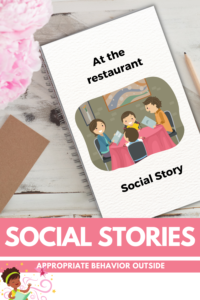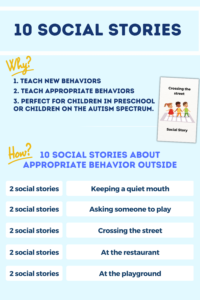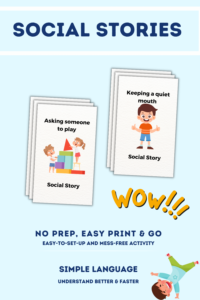Social stories are a simple but effective strategy that can help children with autism thrive. Social stories can be an effective way to help children with autism learn and understand the world around them. They can help children understand new situations, learn expected behavior, and feel more comfortable in social situations. This article explains the many benefits of introducing social stories for children with autism and shows how you can use them effectively.
1. What are social stories
A social story is a short, descriptive story that helps children understand specific situations. Social stories are often used to teach children with autism about new situations, such as starting school or to help them understand expected behavior, such as how to act at a store.
They typically include simple text and pictures that explain what will happen in a specific situation, as well as why the child should behave a certain way.
2. The magic of social stories
Research has shown that social stories can be an effective intervention for children with autism spectrum disorder (ASD), with some studies demonstrating significant improvements in social and communication skills.
a. Understand and predict the social world
One of the key benefits of social stories is that they can help children with ASD to understand and predict the social world around them. This can be particularly helpful for children who often find social situations confusing and overwhelming.
b. Learn social and communication skills
Social stories can also help to build important social and communication skills. For example, they can help children to understand and use nonverbal communication, such as eye contact and body language.
c. Practice and learn social rules
They can also help children to practice and learn social rules and normative behavior. Social stories can teach children to make friends, how to make an apology and many more social behaviors.
d. Tailored to the child’s needs and interests
Importantly, social stories can be tailored to the individual child’s needs and interests, which makes them a flexible and personalized intervention.
e. Social stories are fun
Social stories are a must in any special education classroom because they are a fun and engaging activity that children love doing again and again.
3. How social stories can help your child with autism thrive
Most children with autism spectrum disorder (ASD) have difficulty with social interactions. Many children struggle with understanding and responding to the social cues of others, and may find it hard to make friends. One way you can help your child is by using social stories.
a. Teaching a specific social skill
Social stories can be used to teach your child specific social skills, such as how to make eye contact or how to start a conversation.
b. Teaching the appropriate behavior in social situations
Social stories can also be used to help your child understand the expectations of a particular social situation, such as a birthday party or a trip to the dentist. There are many different social stories available, either online or in books. You can also create your own social story, tailored to your child’s individual needs.
c. Preparing the child for a specific situation
Social stories can help prepare your child to thrive in new or unexpected situations by teaching him what to expect and how to react.
d. Teaching kindly
Social stories are supportive, not critical. This makes them a powerful tool to navigate difficult situations with your child smoothly.
By using social stories, you can help your child with ASD understand social situations and learn the skills they need to thrive.
4. Tips for using social stories with your child with autism
When you are introducing a social story to your child, it is important to keep a few things in mind.
- make sure that the story is appropriate for your child’s intellectual level and that he can understand it.
- keep the story concise and to the point.
- be sure to read the story in a calm and pleasant tone of voice.
- Make sure the story is relevant to your child’s current situation. If you are introducing a social story about going to the grocery store, for example, make sure that it is about a trip to the grocery store that your child will be taking soon.
- Before you read the story, take a few minutes to talk about the situation that the story is about. This will help your child to understand the story and put it into context.
- Read the story slowly and clearly, using different voices for different characters if possible.
- Encourage your child to ask questions about the story. After you have finished reading, take some time to discuss the story with your child and answer any questions they may have.
- Give your child the opportunity to practice the behaviors in the story. If the story is about going to the grocery store, for example, take your child to the grocery store and help them to practice the behaviors in the story.
- Be sure to praise your child for their efforts in learning the new behavior. rewarding your child will help to reinforce the behavior and make it more likely that they will continue to use it in the future.

5. How to create a social story for your child with autism.
Social stories are brief, simple descriptions of a particular situation, event, or activity, written from the child’s perspective. They typically include both words and pictures and are designed to help the child understand what is expected of them in a given situation.
Creating a social story is relatively simple:
- start by identifying the situation, event, or activity that you want to address.
- think about what the child needs to know in order to understand and be successful in that situation. And write the story from the child’s perspective.
- Be as specific as possible, addressing the who, what, when, where, and why of the situation.
- use simple language that the child can understand.
- Once you have the story written, you can add pictures to help illustrate the points you are trying to make.
- Social stories should be brief, no more than a few sentences.
- they should be positive, focusing on what the child can do rather than what they can’t.
6. Example of a social story
Creating social stories can be a helpful way to provide support for children with autism. By focusing on the positive and being specific about what is expected, social stories can help the child understand and be successful in a variety of situations.
Here is an example of a social story written for a child who is struggling with Angry Birds
“I like playing Angry Birds on my iPad.
Sometimes I get angry when the birds don’t destroy the pigs’ houses.
I can take a break from playing if I start to feel angry.
I can ask for help if I need it.”
This simple but effective intervention can make a big difference for children with an autism spectrum disorder. Social stories can help these children develop social and communication skills. With the help of social stories, children with ASD can learn how to appropriately interact with others and Navigate the social world.
For more social stories, check out the Autism Aid Store.




